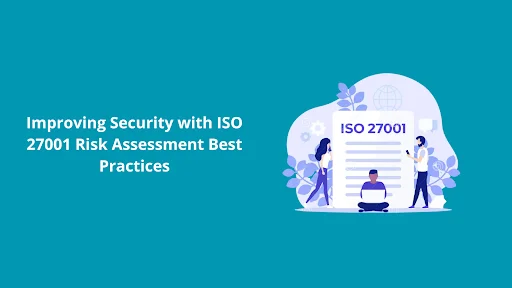Business
Improving Security With ISO 27001 Risk Assessment Best Practices

It is now more important than ever to protect sensitive information from unauthorised access. As the frequency of cyber attacks and data breaches continues to rise, businesses are looking for more efficient ways to protect their data and continue to earn the confidence of their customers. The ISO 27001 Certification, as well as the ISO 27001 Risk Assessment best practices, come into play at this point. Not only can these practices improve security measures, but they also add to an organization’s information management system’s overall resilience.
Table of Contents
Table of contents
- ISO 27001 Certification
- The Essence of ISO 27001 Risk Assessment
- Best Practices for ISO 27001 Risk Assessment
- Benefits of Implementing ISO 27001 Risk Assessment Best Practices
- Conclusion
ISO 27001 Certification
A globally recognised standard, ISO 27001, offers a methodical method for handling information security concerns. Obtaining ISO 27001 accreditation is evidence of a company’s dedication to protecting the privacy, availability, and integrity of its information assets. This accreditation acts as a trust-building barrier, reassuring clients and stakeholders that their data is secure.
The Essence of ISO 27001 Risk Assessment
Risk assessment is a key idea in the ISO 27001 framework. To do this, possible threats and vulnerabilities to the information assets of an organisation must be identified, and their potential effects must be assessed. An organisation may implement efficient procedures to manage risks and thwart possible security breaches by being aware of them.
Best Practices for ISO 27001 Risk Assessment
- Identifying possible hazards is the first stage in the risk assessment process. Understanding the organization’s resources, such as its information systems, data repositories, and procedures, is necessary for this. In-depth analyses and brainstorming sessions might help find weaknesses that could otherwise go undetected.
- Risks must first be recognised before being evaluated for likelihood and possible impact. This aids in ranking hazards according to their seriousness and enables organisations to deploy resources more effectively.
- Organisations establish their degrees of risk tolerance during this period. Certain hazards could be tolerable within specific parameters, while others need quick action. This stage ensures that the company’s security strategy is in line with its overarching business goals.
- The next stage is implementing the necessary controls after identifying and assessing risks. These safeguards may consist of procedural safeguards like access restrictions and personnel training and technology safeguards like firewalls and encryption.
- Risk analysis is a continuous activity. As the threat environment changes continually, new vulnerabilities could appear. The organization’s security measures are kept current and effective by routine monitoring and evaluation.
- It is crucial to have detailed documentation of the risk assessment process. Future evaluations, audits, and improvements can use this material as a guide. Additionally, it supports continued accountability and openness.
Benefits of Implementing ISO 27001 Risk Assessment Best Practices
- Organisations go from a reactive to a proactive posture thanks to ISO 27001 risk assessment. Organisations may prevent possible security breaches and data loss by recognising and reducing risks before they get out of hand.
- Data protection laws are quite strict in several businesses. Best practices for ISO 27001 risk assessment implementation can assist organisations in adhering to these rules and avoiding legal repercussions.
- A strong information security architecture improves an organization’s reputation. Customers, partners, and other stakeholders are more inclined to trust a company that places a high priority on the protection of their data.
- Although there are expenses associated with installing security measures, these costs are sometimes much lower than the monetary repercussions of a data breach. Resource allocation that is more effective and reduces wasteful spending is made possible by ISO 27001 risk assessment.
Conclusion
Obtaining ISO 27001 certification and adhering to its risk assessment best practices can give organisations a solid framework to effectively manage these difficulties. Organisations may strengthen their information security defences, maintain regulatory compliance, and inspire trust in their stakeholders by recognising, analysing, and reducing threats. In a world where data is the new currency, investing in security is essential and a competitive advantage that puts businesses on the road to resilient, sustainable growth.
To know more about keep reading Lemony Blog.

-

 Business3 years ago
Business3 years agoHow to Do Long-Distance Moves with Children
-

 Travel2 years ago
Travel2 years agoQuick Guide: Moving To Santa Rosa?
-

 Real Estate3 years ago
Real Estate3 years agoWhy Dubai Festival City is a Great Neighbourhood for Young Learners
-

 Business3 years ago
Business3 years agoIs Guest Posting a Good Inbound Marketing Strategy?
-

 Business1 year ago
Business1 year agoThe Ultimate Guide To Thriving In Your Printing Franchise
-

 Business1 year ago
Business1 year agoExploring The Benefits And Challenges Of Restaurant Franchising
-

 Tech3 years ago
Tech3 years agoCyber Table That Will Change Your Life
-

 Lifestyle1 year ago
Lifestyle1 year agoDallas’ Hidden Gems: 6 Must-Try Restaurants Off The Beaten Path!









Recent Comments